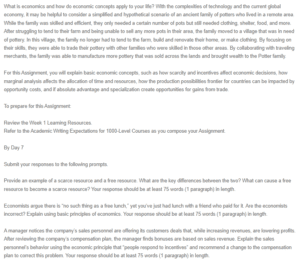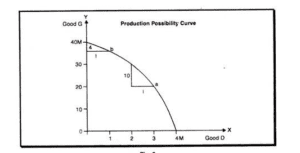Basic Economic Concepts
Scare and Nonscarce Resources
Scarce resource refers to goods and services that people want more than they are available for free. A prime example is coal. On the other hand, free resources are nonscarce goods, even when their price is zero. A typical example of a free resource is air –human life cannot exist without it. A free resource can become scarce if consuming or obtaining them becomes costly.
Opportunity Cost
There is no such thing as “no such thing as a free lunch” is a simple concept of opportunity cost, which refers to the value of the next best alternative use of resources forgone when a choice is made. An opportunity is incurred every time a choice is made because an alternative has been forgone (Beveridge, 2018). In this case, taking lunch with a friend implies that we gave up the opportunity to have other items on the menu.
“People Respond to Incentives”
People’s behavior may change when the costs and benefits change because they make rational decisions by comparing costs and benefits (Frederiks et al., 2015). This fundamental principle of the economy is called “people respond to incentives.” In this scenario, the company’s compensation plan and the sales personnel’s deals to customers send a signal that acts as incentives. As a result, this changes their behavior by influencing the number of goods the sales personnel are willing to offer for sale, and the amount of goods customers are willing to buy.
Marginal Analysis
In this situation, I will use the first seven hours to study course B and use the last one hour to study for course A since course B bears the highest points in my overall grade. From a microeconomic standpoint, time allocation is based on associated costs and estimated benefits (Sato et al., 2015). Using this option will result in a higher grade than starting with studying course A. Typically, applying the law of increasing cost implies that the marginal cost of studying course B would decrease as time elapses.
Opportunity Cost and the Production Possibilities Curve
The shape of an increasing production possibilities curve bows out in the face of increasing opportunity cost. Essentially, the curve’s shape is influenced by allocating resources based on comparative advantage, upholding the law of opportunity cost (Myers, 2022). The downward slope of the curve indicates scarcity. As shown in Figure 1, the marginal cost of production of G for D is increasing. Larger amounts of G must be forgone for additional units of D.
Figure 1: Production Possibilities Curve
Comparative Advantage
There are opportunities for gains in absolute and comparative advantages. To illustrate, a country with an absolute advantage can produce all goods efficiently, avoiding production that would yield little to no demand, causing a loss (Hanson et al., 2015). As a result, country A is better placed to devote its little resources to other product types. Similarly, country B has the necessary resources to produce a wide range of goods. Here, the opportunity for gains from a particular option is equal to the forfeited benefits associated with choosing an available alternative (Beveridge, 2018). As such, absolute advantage determines trade direction as it better serves country A to devote its limited resources and labor to another industry or other types of products.
International Trade
In international trade, both countries with absolute and comparative advantages can benefit. Ideally, despite countries with the absolute advantage being in a better position to produce more products than nations with comparative advantage, the latter countries will still gain from trade (Beveridge, 2018). Accordingly, this is because the cost of production for countries with absolute advantages is equal to the price of goods produced by nations with comparative advantages (Beveridge, 2018). As a result, each country moves beyond its production possibilities frontier and gains from trade.
References
Beveridge, T. (2018). A primer on microeconomics (2nd ed.). Business Experts Press.
Brecher, R., Chen, Z., & Choudhri, E. (2002). Absolute and comparative advantage reconsidered: The pattern of international trade with optimal saving. Review of International Economics, 10(4), 645-656. https://doi.org/10.1111/1467-9396.t01-1-00355
Frederiks, E., Stenner, K., & Hobman, E. (2015). Household energy use: Applying behavioral economics to understand consumer decision-making and behavior. Renewable and Sustainable Energy Reviews, 41, 1385-1394. https://doi.org/10.1016/j.rser.2014.09.026
Hanson, G., Lind, N., & Muendler, M. (2015). The Dynamics of Comparative Advantage. NBER Working Paper Series, 1-76. https://doi.org/10.3386/w21753
Laursen, K. (2015). Revealed comparative advantage and the alternatives as measures of international specialization. Eurasian Business Review, 5(1), 99-115. https://doi.org/10.1007/s40821-015-0017-1
Myers, D. (2022). Construction Economics (4th ed.). Routledge.
Sato, Y., Tan, K., & Tse, Y. (2015). An integrated marginal analysis approach for build-to-order products. International Journal of Production Economics, 170, 422-428. https://doi.org/10.1016/j.ijpe.2015.08.001
ORDER A PLAGIARISM-FREE PAPER HERE
We’ll write everything from scratch
Question

Basic Economic Concepts
What is economics and how do economic concepts apply to your life? With the complexities of technology and the current global economy, it may be helpful to consider a simplified and hypothetical scenario of an ancient family of potters who lived in a remote area. While the family was skilled and efficient, they only needed a certain number of pots but still needed clothing, shelter, food, and more. After struggling to tend to their farm and being unable to sell any more pots in their area, the family moved to a village that was in need of pottery. In this village, the family no longer had to tend to the farm, build and renovate their home, or make clothing. By focusing on their skills, they were able to trade their pottery with other families who were skilled in those other areas. By collaborating with traveling merchants, the family was able to manufacture more pottery that was sold across the lands and brought wealth to the Potter family.
For this Assignment, you will explain basic economic concepts, such as how scarcity and incentives affect economic decisions, how marginal analysis affects the allocation of time and resources, how the production possibilities frontier for countries can be impacted by opportunity costs, and if absolute advantage and specialization create opportunities for gains from trade.
To prepare for this Assignment:
Review the Week 1 Learning Resources.
Refer to the Academic Writing Expectations for 1000-Level Courses as you compose your Assignment.
By Day 7
Submit your responses to the following prompts.
Provide an example of a scarce resource and a free resource. What are the key differences between the two? What can cause a free resource to become a scarce resource? Your response should be at least 75 words (1 paragraph) in length.
Economists argue there is “no such thing as a free lunch,” yet you’ve just had lunch with a friend who paid for it. Are the economists incorrect? Explain using basic principles of economics. Your response should be at least 75 words (1 paragraph) in length.
A manager notices the company’s sales personnel are offering its customers deals that, while increasing revenues, are lowering profits. After reviewing the company’s compensation plan, the manager finds bonuses are based on sales revenue. Explain the sales personnel’s behavior using the economic principle that “people respond to incentives” and recommend a change to the compensation plan to correct this problem. Your response should be at least 75 words (1 paragraph) in length.
You have 8 hours to study for two final exams. The exam for course A is worth 25% of your grade and the exam for course B is worth 50% of your grade. The first hour you spend on studying for either exam will increase your score on it by 10 percentage points, the second hour will increase your grade on it by an additional 9 percentage points, the third hour will increase your grade on it by an additional 8 percentage points, and so forth. How will you allocate your time? Explain your answer in terms of marginal analysis. Your response should be at least 75 words (1 paragraph) in length.
How do increasing opportunity costs affect the shape of the production possibilities curve? Provide an example that illustrates the concept of increasing opportunity costs. Include a graph or illustration to support your answer. Your response should be at least 75 words (1 paragraph) in length, plus the graph or illustration.
Assume country A has an absolute advantage in producing all products compared to country B but country B has a comparative advantage in producing several products. Are there opportunities for gains from trade? If so, what determines the direction of trade? Your response should be at least 75 words (1 paragraph) in length.
Explain how international trade allows a country to move beyond its production possibilities frontier and create gains from trade. Your response should be at least 75 words (1 paragraph) in length.


